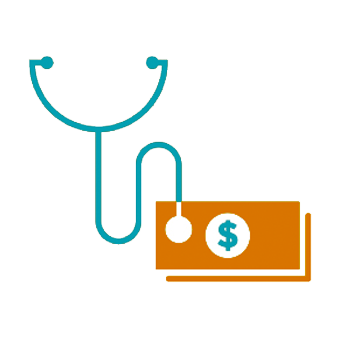This document, written by Hilltop Director of Analytics & Research Morgan Henderson, Senior Data Scientist Leigh Goetschius, and Interim Executive Director Alice Middleton, quantifies the impact of removing the 6% provider tax safe harbor threshold on state-level federal Medicaid funding. Using data on hospital and nursing facility tax rates and net patient revenue, this analysis finds that eliminating the 6% provider tax threshold for hospitals and nursing facilities would put $83.7 billion of federal Medicaid funding at risk.
This one-pager, written by Hilltop Director of Analytics & Research Morgan Henderson, Senior Data Scientist Leigh Goetschius, Director of Aging & Disability Studies Christin Diehl, and Interim Executive Director Alice Middleton, quantifies the impact of removing the 50% Medicaid Federal Medical Assistance Percentage (FMAP) floor on federal spending on Medicaid-funded home and community-based intellectual and developmental disabilities (ID/DD) services in states. The one-pager estimates the federal funding decreases overall and for each of the ten states that would be the most impacted.
This one-pager, written by Hilltop Director of Analytics & Research Morgan Henderson, Senior Data Scientist Leigh Goetschius, and Interim Executive Director Alice Middleton, quantifies the impact of removing the 50% Medicaid Federal Medical Assistance Percentage (FMAP) floor on the federal Medicaid funding to states. The one-pager estimates the federal funding decreases overall and for each of the ten states that would be the most impacted.
The Hilltop Pre- Models are risk prediction models developed by The Hilltop Institute at UMBC that use a variety of risk factors derived from Medicare claims data to estimate the event risk that a given patient incurs a given outcome in the near future. As of November 2022, there are three such prediction models in production for the Maryland Primary Care Program (MDPCP) population: the Hilltop Pre-AH Model™, which generates the “Avoidable Hospitalizations (PreAH)” scores; the Hilltop Pre-DC Model™, which generates the “Severe Diabetes Complications (Pre-DC)” scores; and the Hilltop Pre-HE Model™, which generates the “Hospice Eligibility and Advanced Care Planning (Pre-HE)” scores. These risk scores are displayed in the MDPCP Prediction Tools area on Chesapeake Regional Information System for our Patients (CRISP).
The Hilltop Pre-HE Model™—which generates the rankings for the Hospice Eligibility and Advanced Care Planning (Pre-HE) scores—is designed to support proactive advanced care planning discussions by estimating a patient’s risk of eligibility for hospice. The Pre-HE Model provides risk scores and reasons for risk for all attributed beneficiaries of Maryland Primary Care Program (MDPCP) practices every month in order to identify patients that are potentially appropriate for hospice care and to provide care teams with information that can guide the sensitive and difficult conversations about end-of-life care with patients and their families.
The Hilltop Pre-DC Model™—which generates the rankings for the Severe Diabetes Complications (Pre-DC) scores—is designed to facilitate the active management of type 2 diabetes by estimating individuals’ risk of incurring inpatient admissions or emergency department (ED) visits for severe diabetes complications. The Pre-DC Model provides risk scores and reasons for risk for all attributed beneficiaries of Maryland Primary Care Program (MDPCP) practices every month to help care teams proactively identify high-risk individuals and allocate scarce care management resources.
The Hilltop Pre-AH Model™—which generates the rankings for the Avoidable Hospitalizations (Pre-AH) scores—is designed to assist providers by allowing them to easily identify patients at a high risk of incurring an avoidable inpatient hospitalization or emergency department (ED) visit. The Pre-AH Model provides risk scores and reasons for risk for all attributed beneficiaries of Maryland Primary Care Program (MDPCP) practices every month to help care teams make informed decisions about how to direct scarce care coordination resources to the individuals who will benefit from them the most.
This annual report, written for the UMBC community, provides an overview of key projects and staff accomplishments for FY 2024.
In 1997, Maryland implemented HealthChoice—a statewide mandatory Medicaid and Children’s Health Insurance Program (CHIP) managed care program—under authority of a waiver through §1115 of the Social Security Act. The provisions of the Affordable Care Act (ACA) that went into effect in 2014 marked another milestone by extending quality coverage to many more Marylanders with low income. Over 25 years after its launch, HealthChoice covers close to 90% of the state’s Medicaid and Maryland Children’s Health Program (MCHP) populations. Since the inception of HealthChoice, the Maryland Department of Health (the Department) has requested and received seven §1115 waiver renewals.
The Hilltop Institute, on behalf of the Department, evaluates the program annually; this evaluation covers the period of calendar year (CY) 2018 through CY 2022.
Policy Analyst Advanced Morgane Mouslim, ScM, DVM, presented this poster at the 2024 AcademyHealth Annual Research Meeting (ARM) held June 29 – July 2 in Baltimore.





